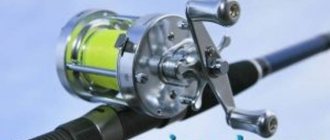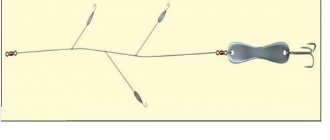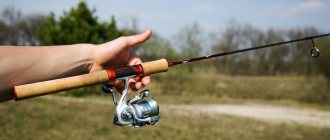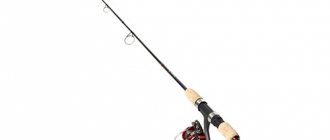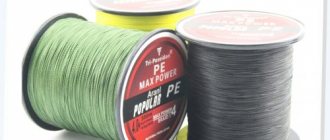General structure of the gear and the influence of individual components on casting
Spinning tackle consists of the rod itself, a spinning or multiplier reel, cord or fishing line and bait.
Each of the components is capable of influencing both technique, accuracy and casting range to varying degrees. Spinning. Fishing rods differ in action, length, material and test. The distance of the throw is greatly influenced by the length of the form. The longer the rod, the further the spinning rod will be cast, however, it should be taken into account that the technique will also be somewhat different. Short rods are often good for casting with one hand, but long rods need to be cast with both. Accuracy and range are also affected by formation. Fast and ultra-fast action forms are generally believed to provide greater bait flight range and accuracy; slow rods are somewhat inferior in this regard.
Coil. How to cast a spinning rod correctly is largely influenced by the type of reel - casting with a spinning reel and a multiplier reel is significantly different. How to properly hold a spinning rod with different reels when casting? For inertia-free, the standard option is that the coil and rings are directed downward, the coil leg passes between the third and fourth fingers of the working hand
In the case of multipliers, it’s the other way around - both the rod rings and the reel itself are directed upward, and the cast itself is less sharp; when casting with a multiplier, smooth acceleration is important
The diameter of the cord or fishing line primarily affects the casting distance. In the vast majority of cases, the appropriate diameter (or breaking load) will be indicated directly on the form. Fishing with thicker lines can significantly reduce the casting distance of the bait.
Mass of bait. Everything is quite simple here. It is strongly not recommended to go beyond the test values indicated on the spinning rod (although experienced anglers who know the capabilities of their rod sometimes throw heavier baits). Depending on the spinning rod model and manufacturer, the casting range can be maximum either when using baits closer to the upper limit of the test, or closer to the middle.
Option on how to properly throw a spinning rod with a spinning reel
Before casting a spinner with a spinning reel, you need to study the technical part. It’s better to get comfortable with a one-handed fishing rod with a hookless spinner weighing sixteen grams. The fact is that the shiny surface of the spinner is more visible visually.
Using spinning reels, the casting technique involves a vertical swing, which is effective not only for shore fishing, but also from a watercraft. After hard training, you can do it while sitting, which is especially important if fishing is done from a rubber boat, as we wrote about in the article “In the middle of a reservoir: catching pike from a boat using a spinning rod.”
Let's consider another casting option.
- We grasp the form with one hand so that the meat grinder leg is between the middle and index fingers.
- We pull up the line until the spoon is at a distance of fifteen centimeters from the tulip.
- We clamp the line with our thumb and fold back the line guide.
- Place the form on your right shoulder and grab the lower part of the handle with your other hand.
- Now how to cast the spinning reel is ready. We sharply send the rod forward, simultaneously pulling the butt back with our left hand.
With this method of throwing bait, the swing is short but quite powerful. There are no spinning reels for long-distance casting; in fact, you just need to learn how to throw the bait at the required distance.
It is believed that it is most convenient to press the line with your index finger, but there are also opponents to this technique. Since the throw is instantaneous, the finger is not able to have time to straighten. The scaffold, sliding along it, flies off, changing direction for a while. This short-term failure leads to a reduction in the spinner's flight range and splashdown accuracy.
The most commonly used casting options are vertical and side
Vertical cast
It is believed that vertical casting of bait has maximum accuracy and range. This casting option is well suited for large bodies of water with a fairly clean shore, on which there are no trees hanging low over the water, or a wall of bushes reaching right down to the water. The technique of casting a spinning rod vertically is quite simple:
First, you should select the length of the line overhang (depending both on personal preferences and on the characteristics of the bait and rods), open the line handle, and the line or cord is fixed with your index finger. The form must be placed behind your back. With a quick movement of the rod you need to send the bait forward, and it is important to release the line in a timely manner.
It should be taken into account that when fishing under power lines, this technique is the most dangerous - if you do not release the line in time, the bait can go quite high up and remain on the wires. This situation can be dangerous for the fisherman himself, because carbon blanks conduct electricity well.
Photo 1. Vertical casting diagram.
Side cast
The horizontal option is good to use in the presence of tall vegetation, which often makes a vertical throw impossible. Also, this type of casting of a spinning rod is often used by novice spinners, as it is one of the easiest to learn. This is how they cast not only in the presence of vegetation, but also in unfavorable weather conditions, such as, for example, a strong side wind. However, this technique of casting a spinning rod does not have high accuracy, and it is better to use it in situations where relatively low accuracy is not critical, and the bait will not be lost due to a miss.
The technique of the cast itself is almost the same as in the case of vertical casting, only the rod must be moved not back, but to the side. As a rule, right-handers throw in the direction from right to left, left-handers vice versa, but sometimes there are situations when it is useful to be proficient in both options.
Photo 2. Side casting diagram.
Methods and techniques for casting a spinning rod with a spinning reel
The most important thing you strive for when casting is accuracy and distance. Before throwing the tackle, you need to make sure that there are no obstacles behind at a sufficient distance - trees, bushes, poles, including living objects in the form of cattle or rivals.
How to cast a spinning rod with a spinning reel: on the other side of the river you need to select a landmark in the direction of which the bait will be thrown. At first, you can practice on sinkers with different weights. By the way, experienced fishermen use Cheburashka to study the topography of a reservoir. The absence of a hook allows you to avoid hooking.
There are not so many options on how to cast correctly, and they are common not only among spinning players, but also among feeders and floaters.
- Side cast
. Used to deliver bait over short and medium distances in strong winds or on an overgrown bank. - Casting from under yourself
. Used over short distances when another cast is hampered by obstacles around the angler. - Throwing from behind
. The rig can be thrown over extremely long distances, despite the power of the wind.
Casting a spinning rod with a spinning reel from behind is convenient if nothing interferes with it. To do this, we wind the reel until the bait is at the level of the third ring. We fix the line with a finger and fold back the line guide. When making a swing, we place the form behind our back. With acceleration, we bring the rod in front of us, removing our finger from the fixed line.
Casting a fishing rod with a spinning reel, unfortunately, is not always accurate, that is, during the fishing process it is not always possible to deliver the bait to the same zone. Therefore, you have to explore the areas, casting in various directions. And this proves that you will have to throw a large number of times.
Fishing with wobblers from the shore
This is an affordable way to catch predatory fish in the absence of a swimming device. But there is a significant disadvantage, unlike fishing from a boat - when you catch on grass, algae, or snags, there is a high risk of the bait breaking. If you lose bait on a boat, there is a chance to swim up and get it, but there is no such opportunity from the shore.
When fishing on an unfamiliar body of water, in order to understand what kind of bottom you have to deal with, it is better to attach an inexpensive bait, which you will not regret if you lose it. When fishing with wobblers from the shore, jerk retrieves with minnow-type wobblers are in demand.
Among the main nuances of such fishing:
- Although the choice of spinning rod length is individual, the generally accepted parameters for twitching are considered to be a range from 1.8 to 2.2 m.
- A very fast action of the tackle is not suitable for jerking retrieves, since due to only a working tip, it is not possible to set the wobbler to the desired dynamics of movement. Therefore, preference is given to the Regular Fast tuning. So, while the wobbler is playing, the blank will work along its entire length and you can increase the casting distance.
- The spinning rod is taken hard so that the form does not fall through during the jerk.
- In this method, the predator is caught at any depth, type of reservoir.
- In fast currents, jerking is not as effective. Here it is better to use uniform or stop and go (with pauses).
Another popular variety of wobblers are shads and cranks. Among the nuances:
- Both types have their own unique gameplay, so the fisherman does not need to provide additional animation.
- The rod is not taken as rigid as for twitching.
- Build – Regular Fast.
- Cranks are used on riffles near the shore, in shallow water. Used on chub, ide, pike perch, asp, perch.
- Shad are caught in holes near the shore, places with sharp changes in depth. Perch and pike perch are responding.
There are surface wobblers on sale with a depth of no more than 20 cm:
- poppers;
- walkers;
- minnow.
With such a bait you will again need jerk wiring. Fishing places: shallow river beds, shallow lakes.
How to make the longest cast
Important! The farthest sends of baits allow fishing rods over three meters, fast or semi-fast action. Consequently, the casting distance depends on the type of swing and the length of the tackle.
When considering how the long-distance casting technique is carried out, you need to build on the classics of vertical casting, only in addition to this technique is putting the greatest force into the swing
Consequently, the casting distance depends on the type of swing and the length of the tackle. When considering how the long-distance casting technique is carried out, you need to build on the classics of vertical casting, only in addition to this technique is putting the greatest force into the swing.
How to make long casts with a spinning rod
In order to cast bait long distance with a spinning rod, it is necessary not only to perform the cast technically correctly, although this is, of course, very important, but also to properly prepare the tackle. Also, it is worth understanding that the bait will fly further, the heavier it is.
Also, it is worth understanding that the heavier the bait will fly, the further it will fly.
Light baits are not designed for long casting.
A headwind will also interfere with long casting and all this must be taken into account. Let's look at all the factors that will influence casting distance.
The length of the rod has a direct impact on casting distance, since, in essence, it is a lever. The longer the lever, the easier it is to make a long cast. For long casts, choose a rod at least 3.1 meters long.
Coil. The larger the reel, the more fishing line or cord it holds, the further your bait will fly. A large wide reel is one of the factors influencing the flight range of the bait.
Winding line
In order for the bait to fly far, it is very important that there is a maximum of fishing line or cord on the reel. It is optimal to wind the fishing line so that there is 1-2 mm left to the edges of the spool
Then the line will come off the spool with the least resistance and fly further. If the spool is large and you are fishing using a cord, then a more economical option would be to first wind regular monofilament onto the reel, and then the required amount of braid. Thus, only the cord will work for you, and the excess volume of the reel will be filled with cheaper fishing line.
Read Do-it-yourself snowmobile made from a chainsaw
Passing rings. When assembling the rod, align the rings evenly so that they all go at the same level and the line passes through them evenly. If one ring is to the left, the other to the right, then the friction of the fishing line against them will increase, which will lead to a reduction in the flight range of the bait.
Casting technique. And, of course, the casting distance will depend on how you perform it. In order for the bait to fly far, you need to make a powerful and sharp throw.
The swing should not stop at the back point. Everything should happen without stopping - move the rod behind your back and immediately send the bait forward, like a pendulum. Use the flexibility of the rod to send the bait further.
You need to increase your casting distance using more than just hand strength. You need to work with your body at the same time, then you transfer additional impulse to the spinning rod. To do this, you need to slightly turn your body towards the rod, and when casting, your shoulder is thrown towards the flight of the bait.
In addition to the work of the body, even the legs come to the rescue. While casting, take a step forward with the foot opposite to the hand from which you are holding the spinning rod. If you are casting from your right shoulder, you should lunge with your left leg as you cast. Thus, you will increase the flight range of the bait by several more meters.
During casting, when your finger has already released the line and the bait is flying in free flight, hold the rod so that it forms an almost straight line with the line. This way, the friction of the fishing line on the guide rings will be minimal and the bait will fly further
Learn to feel your tackle, this is very important for both casting distance and accuracy
How to make an accurate cast with a spinning rod
Accurate casting technique requires hard training. Moreover, casts should be targeted in order to ensure the accuracy of bait delivery. It is better to do training daily, and not necessarily on a pond. Precision casting is a technique of masters who are able to deliver bait to any point where there is an area of clean water that is not overgrown with algae.
This technique is only feasible if vertical casting is used. It is this technique that allows you to deliver bait with amazing accuracy. This technique has already been mentioned in this article, so there is no point in repeating it. The main thing is that everything is selected correctly, including the tackle with bait. A small weight bait, for example, an ultralight one, will not fly far, and besides, you will need an ultralight rod. Plus, you need a thin fishing line with a light, not large reel.
The long-distance casting technique still requires more powerful and rigid gear, along with the “ensuing consequences,” ranging from a heavy bait to a powerful reel with strong fishing line.
When making long and accurate casts, you should remember that the further the distance, the more difficult it is to send the bait to a given point. As practice shows, everyday training does not go unnoticed and it is absolutely possible to master the technique of long-distance and accurate casting.
How to cast a spinning rod
There are many different casting methods. The most important of them are the side cast and the overhead cast. In addition to these, there are several other types of casting that depend on the situation, for example, when there are branches, bushes or trees behind the angler.
Regardless of which reel the angler uses, a spinning reel or a multiplier, the casting dynamics are the same - movement, acceleration and the moment the line is released. However, each type of reel requires the angler to handle the rod differently.
Side casting spinning rod
When casting a spinning rod from the side, the bait should hang from the end of the rod by about 30 centimeters. The rod is pulled horizontally back to the left or right side depending on which hand you have the rod in. When casting, the rod moves forward and slightly upward, and at this moment the line is released. If, when casting from the right side, the bait goes too far to the right, then the line was released early. If the bait goes to the left, it means the line was released too late. If the bait falls exactly in front of you, the cast is excellent. Side casting of a spinning rod usually does not provide accuracy, but it is the simplest and often the most powerful.
Throwing a spinning rod over your head
Throwing a spinning rod over the head is most accurate. The angler stands facing the casting direction, and the bait hangs about 30 centimeters from the end of the rod. The end of the rod points towards the target. Then the rod is brought to a vertical position with accelerated movement, its end bends back under the weight of the bait. At this moment, the rod is sent forward with a sharp movement, and the line is released. If the bait falls with full force right in front of you, the line was released too late. If it lands softly in the same place, the cast was too weak or the line was released too early.
An overhead cast is not always suitable for shallow water as it leaves more loose line in the air than a side cast. Side casting ensures faster contact with the bait when reeling in. An overhead cast can be slowed down by holding the line with your finger when using a spinning reel or by braking the multiplier spool with your thumb.
When fishing for a specific fish or in a certain place, the casting trajectory should pass over the target and end a few meters behind it, so that the splash from the falling bait does not spook the fish. Then the bait must sink to a certain depth, where the predator will notice it and grab it.
Casting a spinning rod from under the arm and from the shoulder
The shoulder cast is a special type of cast used in cramped circumstances, such as in a boat or when the target is obscured by tree branches. In this case, the cast is made over the opposite shoulder.
An underhand cast is necessary when there are tree branches or bushes behind the angler's back. This is a short cast, which is used on banks covered with dense vegetation. In this case, it is best to use a spinning or closed-type reel. To make such a cast using a baitcasting reel requires a lot of skill from the angler. When fishing from a boat, where the angler has to stand up to cast and often has a companion behind him, another situation arises where the open space in front of him is suitable for underhand casting.
Throwing a spinning rod with two hands
More powerful casts are made basically according to the same pattern, but require more tension in the body and arms, as well as a two-handed rod.
One of the most common problems with casting a spinning reel is having too much line on it. Large pieces of fishing line quickly unwind and become tangled. To solve this problem, you just need to shorten the line. A cast that is too short can be explained by the lack of line on the spool or the bait being too light. Small guides can also cause a short cast.
When using a baitcasting reel, the most common problem is poor spool drag, which leads to beard formation. To solve this problem, the strength of the magnetic brake must be increased. If this does not help, then the line is too elastic, and these reels are not designed for casting lightweight baits. On reels without a line guide, you can avoid jerking and tangling of the line by using your thumb and forefinger to evenly wind the line onto the spool. Another reason for poor casting can be a loose line wound on the spool, for example, when fishing with a jig. When reeling in a fishing line with a lightweight bait, it should be held with a slight force between the thumb and forefinger.
Source
How to cast a spinning rod correctly: casting methods
First, you need to understand how a spinning rod is cast in general and how it can be cast, depending on the fishing conditions. After all, fishing conditions can be different, depending on the body of water. This could be a body of water with clear banks or a body of water where thickets make it difficult to approach clean water. In addition, thickets are possible in the water, which requires very precise casting. Based on real conditions, it is possible to use the following spinning casting options:
- Vertical.
- Horizontal.
- Pendulum.
- Ejection.
And now, in more detail about the technique of each cast.
Vertical cast
It is used almost always if nothing on the shore interferes. This is a very easy to learn and effective casting method that allows you to deliver the bait exactly to the designated location.
Vertical casting over the head is the main option for casting spinning lures. To carry it out, you need to find a point on the surface of the water where the bait is supposed to be delivered. Using a reel, the line is reeled in so that the bait is 20 cm from the tip of the rod. After this, the line arc opens and the line is pressed with the index finger to the rod blank.
Horizontal (side) cast
This casting technique is very effective on small rivers, where long-distance casting is completely useless, but precise casting is just right. In this case, the bait flies above the surface of the water and hits exactly the place that is located under the branches of trees hanging over the water.
The only drawback of this throwing technique is the need for long training. It will not be possible to cast the bait accurately and correctly the first time. If you master this technique perfectly, you can safely consider yourself a master of spinning fishing.
How to perform the horizontal casting technique
The casting technique is the same, only the spinning rod is not retracted behind the back, as in the first case (with vertical casting), but to the side, either to the left or to the right. As in the first case, first you need to decide on the casting direction and the bait delivery point. The accuracy of casting depends on the moment when the line is released from the clamp. In the process of horizontal casting, a clear reaction is required for timely release of the line, which is only possible after long training.
Pendulum and catapult casting
Pendulum and catapult casting are used very rarely due to the complexity of its implementation and difficult fishing conditions. This can happen if there are significant thickets on the shore, and the place is very promising. But before that, you should think about how you will subsequently be able to pull the bait out of the water, and even more so with a trophy.
How to perform a pendulum cast
You need to pull the bait to the tip of the rod, lower the line handle and grab the line with your finger. After this, the bait seems to swing and with a sharp movement from under itself is directed to the desired point. The main thing is not to forget to remove your finger from the fishing line in time.
This technique will not allow you to cast the bait far, but this is not required, since the main task is to send the bait exactly to the designated place, although not far from the shore.
How to make a catapult cast
The difficulty of casting lies in the fact that you need to pull the bait with one hand, pulling the line, and with the other hand hold the rod and fix the line. Without certain skills, such casts are quite difficult to perform.
Cloudflare Ray ID: 63a9afaaefc34c7f • Your IP: 195.64.208.251 • Performance & security by Cloudflare
With this method of throwing bait, the swing is short but quite powerful. There are no spinning reels for long-distance casting; in fact, you just need to learn how to throw the bait at the required distance.
Pendulum cast
You need to open the wall of the reel and let more than two thirds of the rod hang down.
Next, you need to make two or three swings and throw. Now you need to do the same and close the reel bracket and place the fishing line in the roller. The pendulum throw can be done in a straight line, or it can be done a little to the right or a little to the left. It depends on the fishing conditions. That is, if there are bushes, stones or other obstacles in front of the place where you are going to fish.
There are no alternatives to pendulum casting when you are fishing delicately, directed or have a specific goal. It is simply irreplaceable when fishing at precise distances. It can be used when fishing in clearings near aquatic vegetation, more precisely, for example, between snags or stones.
This technique is very convenient, since the bait flies very slowly, it is clearly visible, and you can simply slow down the line in the right place. Typically, such throws have an accuracy of up to 5 centimeters.
You can watch the video on how to cast a spinning rod correctly. Everything is explained there thoroughly and in detail and you can see all the casting techniques yourself. You must be able to cast correctly, since it is on this technique that your fish catch will depend.
After studying all the information and taking all the fishing gear, you can safely go fishing. For beginners, it is best to practice fishing techniques in those reservoirs where there are no special obstacles. And over time, when your skill is noticeable (in the form of a catch), you can move on to more complex areas of reservoirs.
Using these tips, you can have an unforgettable fishing experience and, of course, return home with a great catch.
Read Fishing with a spinning jig and choosing gear
Types of casting
Correct casting of a spinning rod is a fundamental factor for successful fishing. Beginning fishermen do not always know how to cast a spinning rod in order to hit the desired point and send the bait to the maximum distance.
First of all, you need to pay attention to the correct balancing of the tackle, and only after that choose the right type of casting tackle. The choice of casting type depends on the fishing conditions and your skills, as well as on the characteristics of the gear used
Side cast
This method is most often used to cast a spinning rod from the shore. Great for fishing in strong winds and in difficult conditions. When the banks of a reservoir are densely overgrown with reeds or aquatic vegetation, you can only deliver bait into the water using a side cast.
When using such a cast, it is important to pay attention to the fact that the bait hangs from the tip of the spinning rod by about 30 centimeters. Now you need to move the rod back and in the opposite direction, as shown in the diagram above. When casting, the line must be released at the moment when the rod passes the top point
When casting, the line must be released at the moment when the rod passes the top point.
If you notice that the bait has fallen exactly opposite you, then the cast can be considered successful with full confidence. This is one of the easiest ways to cast a spinning rod, which is often used by novice fishermen, but the accuracy suffers a little.
Over the head
This method of casting allows you to deliver the bait into the water with great accuracy; only to implement it you will need to equip the rod with a spinning reel. The inertial reel significantly reduces the accuracy of casting over the head.
This is how most fishermen cast their spinning rods, including me. It is great for fishing from a boat and from the shore, even if there are bushes nearby. True, beginners often make mistakes when throwing over their heads - they either lower the spinning rod too much behind their back, or apply too much physical force.
Accordingly, if you make a mistake, you will significantly reduce the casting accuracy
It is important that the bait describes an elongated circle while casting. When it passes the extreme point behind the fisherman’s back, the line must be released so that the bait does not stop, but continues its movement, picking up speed.
From under the hand
This type of casting does not have a particularly long range, but it can be used in any conditions. But in this way you can throw bait in any conditions. Most often, casting is used when fishing from a boat with two people or when fishing from the shore in dense thickets.
You can cast a spinning rod in this way using any reel, which makes it virtually universal, since both closed-type and inertia-free reels are suitable. All you need to do is stretch the spinning rod out in front of you in a horizontal position, then tilt its tip down a little and make a sharp rise up.
All that remains for the fisherman is to wait until the tip of the rod takes a horizontal position and release the line. Immediately after this, your bait will go to the fishing spot. The main thing is not to miss the right moment and release the line on time.
Over shoulder
This type of casting allows you to effortlessly cast bait in places where there is very narrow free space. You need to take the spinning rod in such a way that one hand is on the handle, and the other is slightly above the reel. Now tilt the spinning rod back so that the reel is at the level of your shoulder.
Now you need to tilt the spinning rod so that its tip almost reaches the ground and make a sharp jerk, just don’t overdo it. As soon as the spinning rod is at the level of your head, you need to release the line.
When you notice that the bait will soon fall into the water, you need to point the tip of the rod approximately at the point where the bait will fall, and then observe. As soon as the bait is in the water, you need to close the bow and reel.
With two hands
This casting method allows you to make the most powerful and long-distance casts, and doing it is no more difficult than previous methods. But to use it, you will need to use a spinning rod with two handles and apply much more force (with long-term fishing, your muscles will get tired faster).
Features of spinning casts
Spinning reels
Casting can be done from various types of spinning reels, of which there are three main varieties:
- Inertial reel - has significant inertial force and is a simple drum for winding fishing line, sometimes equipped with a ratchet, stopper and other simple devices, allowing you to store quite a lot of fishing line;
- Inertia-free coil - designed specifically to dampen the inertial force of the send and has a rather complex design of closed and open options;
- A multiplier reel is a technological modification of an inertial reel, which is a powerful micro winch that can perfectly dampen inertia and lay the line without twisting it.
Inertial-free Inertial Multiplier
Casting equipment with an inertial reel. Casting when using an inertial reel differs in that at first the rotation speed of the reel and the flight of the equipment are approximately the same, and then they begin to differ.
The bait loses speed much faster than the reel, and at the moment the first one splashes down, the latter continues to spin inertially, tangling the line into “beards”. To avoid this, spinners control the speed of the reel with their index finger and stop it completely at the moment of splashdown, which sometimes requires quite a lot of effort, especially with powerful casts and heavy baits.
To learn this art, you need a lot of experience and more than one unraveled “beard.” Inertial reels require more massive baits, although there are modern lightweight models with low inertia (the lighter the weight of the drum, the lower the inertia).
Casting equipment with a spinning reel. Now the most familiar to our fishermen, the inertia-free “meat grinders” allow you to catch fish spots more comfortably and at a faster speed without making much effort and almost without worrying about the possibility of “beards” occurring.
Although such reels are called inertia-free, they do not at all guarantee the fisherman 100% protection against line tangling, especially in open structures. Inertialess reels in spinning fishing are suitable for purely sporting and recreational fishing for small and medium-sized fish, and are least suitable for landing trophy specimens.
But with such a reel it is easy to send a bait weighing only a few grams to 20-30 meters, which is impossible in the inertial version. Inertia-free reels are produced in numerous model modifications with different specializations of casting and retrieving.
The essence of marketing proposals is that the best solution would be to purchase a special spinning reel exactly for certain fishing conditions, the type of bait and the power of the blank, ignoring the principle of universality. The use of low-power, inertia-free reels for casting stubborn baits is not recommended, but for super-light gear you need delicate and sensitive reels.
When casting, the index finger also helps send, but controls not the reel drum, but the line itself at its exit, and only slowing down the line (especially when the bait enters the water) is required, and not stopping it completely. Casting equipment with a multiplier reel. This is a complex, but the most versatile and preferred option for spinning fishing.
Multiplier reels allow you to cast almost any bait (except super-light ones) to a distance of several hundred meters that is unattainable for spinning baits. Such reels do not twist the line when laying, have greater sensitivity and a soft stroke.
With their help, you can land large and very large trophies up to 60-70 kg inclusive without fear of breakage. True, the prices for these reels are quite high, and their use requires training practice. Before the first cast, manual adjustment of the braking system relative to the weight of the bait is necessary. A properly configured multicast reel usually does not require you to brake the line with your finger.
Spinning wires
A big role in spinning fishing is played by the types of bait retrieves after casting. The goal of competent wiring is to imitate as completely as possible the natural behavior of the original by the layout (bait). But this is not enough.
The wiring should not only show the natural movement of the bait, but also create its maximum attractiveness (for example, imitation of an easy catch - a wounded or weakened individual). Postings may vary depending on the weather, reservoir conditions and fish behavior.
The main spinning lines come in the following varieties:
- Stepped - imitates easy prey, ensuring the movement of the bait in zigzags, in the water column or falling to the bottom, using a rod and reel;
- Jumping - imitates a fish searching for food at the bottom with the help of sharp and short twitches of the fishing line;
- Tolerable - imitates fish drifting with the current using lightweight baits with neutral buoyancy;
- Runaway - imitates attempts to quickly retreat a fish using sharp and long jerks of the fishing line with long pauses;
- Twitching - imitates various fish behavior by using an improvised combination of all types of postings;
- Linear Retrieving - Simulates the simple, targeted movement of a fish using a simple linear movement of the bait in a selected layer of the water column.
Spinning lures
More than 50% of fishing success depends on spinning bait. There are extremely many varieties of baits, both factory-made and homemade. But the entire huge species mass of these baits is divided into types, the use of which, under certain conditions, brings greater success. The main types of spinning lures are as follows:
Spoons
The most common lures for spinning casting, imitating fish and other aquatic life, as well as their characteristic movements. Spoons differ in the type of play they have in the water, casting distance and specific purpose. Spoons are suitable for almost all types of spinning fishing, including all types of casting and retrieving.
Main groups of spinners:
- Oscillating (regular) spinners. They have a general concave petal shape and vary in color and material. They vibrate in the water with a low-frequency amplitude, thereby attracting fish. The most common group of spinners, used mainly for catching pike and perch.
- Spinning (rotating) spoons. They also have a petal shape, but the petal rotates around its axis. Used primarily for perch and pike perch.
- Castmaster spoons (plaques). They have the appearance of a flat diagonal-conical cut of a cylinder. They are distinguished by their large weight and sending range. Works great with jumping and step retrieves. Used for many types of fish.
- Devon spinners (propellers). Integral or composite structures with the introduction of protruding propeller elements, allowing them to quickly rotate around their axis. Devons require long casts and high-speed retrieves to provide torque. Fish like perch and asp are caught with this rig.
- Bladebait lures. Flat or three-dimensional imitations of insects, their larvae, as well as tadpoles. Give good results with twitching and linear wiring. Can attract all predatory and many omnivorous fish.
- Silicone and foam rubber (soft) baits (crustaceans, squid, vibrotails, twisters).
Oscillating Blade Propellers Plaques Vibrating tails and twisters Rotating
These baits also imitate various insects and their larvae. Such baits are usually attached to a jig sinker or a leader. They require a soft stroke of the reel and jumping or step jigging in the bottom layer, when casting short and medium distances. They can catch a wide variety of fish, both predatory and herbivorous.
Wobblers
Quite an extensive class of spinning lures for various types of casting and retrieving. They are made in the form of highly realistic three-dimensional models of fish fry from various materials, convenient for subsequent regulation of their buoyancy levels.
The main types of wobblers are as follows:
- Wobbler. Has neutral buoyancy. They are equipped with a blade in the front part, which allows the wobbler to make diving movements, attracting predatory fish. The size of the blade and its angle of inclination relative to the fishing line determines the diving depth of the wobbler.
- Popper. Possesses positive buoyancy. Instead of a diving blade, it has a cavity with side holes to imitate the gurgling and play of a fry on the surface of the water, provoking pike and perch to attack.
- Rattlin. Has negative buoyancy. Manufactured with complete disregard for the principle of absolute naturalness in the form of flat, smooth fish-like baits (sometimes equipped with a rattle), the hydrodynamics of which provide them with a striking unnaturalness and visibility. Many predatory fish show aggression towards atypical phenomena in the water and attack, which is what we were counting on.
Popper Rattlin Wobbler
Spinning casting technique
There are several basic rules. Following them will help a novice spinning player avoid initial mistakes and cast correctly, far and accurately.
Overhang of the bait
Overhang is the distance from the bait to the tip of the spinning rod. It is often recommended to make the overhang of the bait 30-40 centimeters from the tulip, as the most optimal. But here you need to take into account such characteristics as:
- Spinning rod length.
- Rigidity. Different types of bait load the spinning rod differently. If the overhang is short, the cast will be short, since the form will not be loaded enough. With an increased length, casting accuracy suffers, and inconveniences arise for the spinner.
- Bait type. Throwing a spinner (oscillating or rotating) is different from throwing a wobbler. Pinocchio is voluminous and has additional long-casting systems inside its body. In order for the system to work, the bait should be thrown with acceleration.
Line retention when casting
There are two types of line retention when casting:
- The first is when you press the line against the side of the reel spool with your index finger.
- The second, most common, is holding at the handle of the spinning rod (as in the photo).
The position of the spinner's hands when casting
Casting a spinning rod with one hand looks beautiful, but I still recommend giving up the apparent beauty and grasping the handle with both hands. Regardless of the blank length, weight and type of bait. Each hand performs its own function.
In principle, these are the main points that first of all need to be paid attention to when mastering the technique of casting a spinning rod for a novice fisherman. Of course, there are quite a lot of nuances and you will have to get acquainted with them
For example, the fight against overlapping tulip fishing line.
For clarity, I can offer a video about the technique of casting a spinning rod from Kirill Gushchin, where all the episodes are perfectly described.
The video is wonderful, I just want to warn beginners against completely copying the actions of a professional when working with a loaded form. Kirill has a lot of experience and good spinning. With budget Chinese chopsticks, such tricks may not work and will lead to breakdown.
Types of casting spinning rods
The next point that a novice spinning angler should get acquainted with is the types of casting. In theory there are 5 of them, but in practice there are several more. The fact is that the casting technique of two spinning players, even if they follow the same recommendations, will have differences.
- Technical characteristics of the spinning kit.
- Type of bait used.
- The physical and psychological characteristics of the fisherman himself.
Therefore, I want to warn a beginner not to worry if something doesn’t work out the way an experienced colleague on the shore or a professional from a video did. The spinner constantly hones his spinning technique during his fishing trips.
So, types of casts:
- Pendulum cast.
- Side cast.
- Shooting (catapult) cast.
- Power cast.
- Overhead throw.
Each of them has characteristics, features and is divided into additional branches. For example, a pendulum cast can be a classic bottom (also called English ) and top.
Perhaps I will be wrong, but I will exclude from this story the description of each cast with the pictures attached according to tradition.
Firstly , there is already enough such information on the Internet. All you have to do is type “types and techniques of casting spinning rods” into the search engine.
Secondly (this is a purely personal opinion), the description of casts in mastering a spinning rod will not play a special role for a beginner. This is only a theory, in practice, as I already said, any spinning player necessarily has his own “trick”.
If an experienced spinning player has already mastered all the movements and occurs automatically, then for a novice spinning player it can result not only in the breakdown of gear, but also a threat to the safety of nearby fishermen. There are plenty of cases when bait tees do not enter the jaws of a pike, but into parts of the body of a partner or a hobby colleague passing by.
Common mistakes made by newbies
Beginner fishermen, as a rule, make a number of mistakes because they do not fully understand the technical intricacies of proper casting. Unfortunately, for many, these mistakes develop into a habit, and then it becomes much more difficult to unlearn.
It is more difficult to learn to cast with an inertial reel
Let's list the most common mistakes made by beginning spinners:
- The overhang of the bait is too short or too long;
- Shifting the spinning rod to the left hand at the moment the bait flies;
- Using a bait whose weight does not correspond to the declared test range of the rod;
- Untimely closing of the line handler at the moment of splashing down the bait;
- Excessive braking of the spool or complete ignoring of this nuance;
- Incorrectly adjusted clutch when fishing with a multiplier reel;
- The friction mechanism is too relaxed when using a spinning wheel.
You should make it a rule to always look around before casting. After all, you can get caught on vegetation on the shore and other “obstacles.” Moreover, due to inattention, you can injure yourself or injure your fishing partner. This is especially true in cramped conditions, particularly in a boat.
Types of casting
Side
The most common type, which is carried out from the shore. It is perfect when there is a gusty headwind, or when the shore is heavily planted with bushes, which will be very disturbing. When areas of the reservoir are massively covered with aquatic vegetation, this species will come in handy for casting a spoon under this vegetation.
In a side view, the bait should hang 20-30 centimeters from the end of the spinning rod. We move the rod back to the side opposite from the one in which we hold it. Having cast, we observe that the rod moves forward and slightly upward, during this period of time the fishing line drops.
The cast is considered successful when the bait falls exactly in front of us. Side casting does not differ in extreme accuracy, but for beginners it is the most convenient and easiest.
Over the head
This type allows for almost 100% accurate casting, but it can only be done with a spinning rod equipped with a spinning reel. With an inertial reel, casting accuracy will be reduced by almost half.
Read Fly fishing rod
We can say that this is the main type of casting for many fishermen. Suitable for fishing from a boat and on the shore near bushes. The most common mistake made by beginners trying this method is excessive use of their own strength and pausing by lowering the spinning rod extremely low behind their back.
With such errors, the accuracy will be extremely reduced. During casting, the bait should move in an elongated circle. When it reaches the extreme position behind the fisherman, it must continue moving forward without stopping, while picking up speed.
From under the hand
This type of casting is fairly close, which can be used on the shore, where dense vegetation predominates, as well as when fishing together on a boat, where the fisherman sits almost closely behind him.
For this variety, a closed-type reel and, of course, a spinning reel are perfect. We pull the rod out with one hand in an almost horizontal position in front of us, then tilt the tip of the tackle down, point it towards us, and then lift it.
When the stick takes a horizontal position, release your finger from the spool so that the prepared bait is in free fall.
Over shoulder
In narrow places, you can use the over-the-shoulder casting technique. To do this, we hold the end of the tackle handle with one hand, and with the other near the reel, throwing the rod vertically and tilting its tip over the shoulder, making sure that our reel is above the shoulder.
Having tilted the top almost to the ground, we sharply jerk forward, but in order not to overdo it, remember that the forward swing should not be further than our head. Having the rod above your head gives us a signal that it’s time to let go of your finger from the spool and allow the bait to free fall.
When the descent of the reel comes to an end, we tilt the top of the spinning rod in the direction where our bait went.
With two hands
Using the same scheme, you can make a cast more powerful than the previous ones thanks to this type. But you should know that it will require much more arm and body tension than the varieties listed above, and you will also need a two-handed rod.
Problems that may arise during application:
- The presence of a large amount of fishing line on the spinning reel. They will get tangled when unwinding.
- Light bait and small guides will not allow us to make a long cast.
- To avoid tangling the line on a reel with a missing line guide, you need to help with your thumb and forefinger when winding the line onto the spool.
Having arrived at the place and started choosing the position from which we will cast, we pay attention to:
- The influence of the current if we fish in flowing waters.
- We roughly estimate the amplitude of movement of our bait.
- The fish will not want to follow the bait that is facing the sun, so we choose a place to cast at a low angle to the sun's rays.
Tips and tricks
First, the fisherman must choose a suitable place. The correct position allows you to increase your catch several times. When choosing a position you need to consider:
- amplitude of movement of the bait used;
- flow;
- vegetation;
- various obstacles.
Tips for choosing a casting technique:
- With two hands . Allows you to increase power several times. Thus, the casting distance is maximized.
- From under the hand. Used in reservoirs with dense vegetation, as well as when fishing with two people from a boat.
- Lateral . This technique is effective in strong winds and abundant vegetation.
- Over shoulder . Effective in narrow spaces.
- Over the head . The main advantage is accuracy.
Only you decide which casting method to choose, the main thing is that it is effective!
What kind of spinning equipment are there?
Fishermen have come up with many options for spinning equipment. The most popular include:
- “diverter leash”;
- "Carolinian";
- "drop shot".
The “retractable leash” is very helpful when the predator does not show high feeding activity. Such equipment should be carried out in stepwise manner at the very bottom. The duration of pauses ranges from 4 to 10 seconds. This rig is knitted as follows:
- a triple swivel is attached to the main cord;
- a fluorocarbon leash about 70 cm long and 0.22 mm in diameter is attached to the opposite eye of the swivel;
- a weight on a short leash 15 cm long is tied to the lower eyelet;
- An offset hook is attached to the leash, onto which a vibrating tail or twister is attached.
The “Carolina” rig is excellent for fishing in snags in the reservoir. This equipment allows you to fish in places where other rigs are immediately hooked. It is in such areas that trophy fish prefer to stay. They are collected in the following sequence:
- a “bullet” weight weighing 5–12 g is put on the main line;
- a buffer silicone bead is placed on the monofilament;
- a swivel is tied to the end of the fishing line;
- a fluorocarbon leash about 50 cm long and 0.22 mm thick is attached to the free eye of the swivel;
- An offset hook with a silicone bait is attached to the leash.
A rig called “drop-shot” has proven itself well for catching passive perch and pike perch. The manufacturing process consists of several stages:
- a single hook is put on the main monofilament (its tip should point towards the spinning rod);
- the fishing line is threaded several times into the eye of the hook and secured with a simple knot, leaving a free end about 40 cm long;
- A weight weighing 10–40 g is attached to the end of the monofilament.
Having learned how to tie various types of rigs, a beginner will be able to find the key to fish in any type of reservoir.
Spinning casting basics
Before you begin practice, you need to consider the design of the spinning rod and determine how it works.
Theory
The design of a spinning rod ready for fishing consists of:
- rods with guides;
- coils;
- fishing lines;
- leash with bait.
The rod has a thin conical shape. The thick end of the rod is called the “butt”, the thin part is called the “top”. Fiberglass, plastic, and metal are used to make the fishing rod. There are several characteristics that determine the choice of fishing rod:
- Length – indicated in meters (for rods of European and domestic production) and in inches (for American models).
- Test – recommended weight of the bait to be thrown. It is mainly measured in grams. There is a maximum and minimum value. This indicator, in turn, affects the class.
- Ultra-light – test up to 5 grams.
- Light - test 7-15 grams.
- Medium – test 15-40 grams.
- Heavy - test 40 grams or more.
Action – indicates the modulus of elasticity of the rod. The devices are distinguished:
- fast action - only the tip of the rod bends;
- middle – slightly covers the middle part;
- slow - the entire structure bends under maximum load.
The rigid rod ensures sensitivity to the slightest vibration. You can quickly feel the fish and react in time. On the other hand, rigidity makes it difficult to cast over long distances. The more rigidity, the less whiplash.
Class is a general characteristic that combines the three previous indicators. Fishing rods are conventionally divided into six classes, which differ in the thickness of the fishing line used, the weight of the bait and the planned catch:
- UL - (ultralight) - ultra-light;
- L - (light) - light;
- ML - (medium light) - medium-light;
- M - (medium) - average;
- MH - (medium hard) - moderately heavy;
- H - (heavy) - heavy.
There are two types of coil:
- Inertial.
- Inertialess.
Inertial reels are the very first devices that began to be used for spinning rods. They are easy to use and can be repaired independently without the involvement of a specialist. This type of reel is not the most popular today. A variation are more complex multiplier reels - they have an improved design, but the principle of operation remains the same.
Inertia-free reels prevent tangling and excess line shedding due to the absence of spool torsion. After casting, the reel is fixed and controlled in the same way as an inertial one.
fishing line
The fishing line is chosen depending on the type of fish that you plan to catch. The smallest diameter is 0.25 mm. For training, a medium fishing line with a diameter of 0.5 mm is best suited. It is wound from the bottom side of the reel and threaded into rings located along the entire length of the rod. Then a leash with bait is tied to the end.


